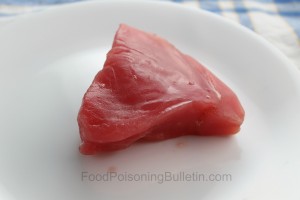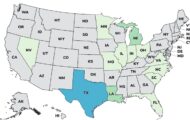A 2011 study by researchers at the Johns Hopkins Center for a Livable Future (CLF) at the Bloomberg School of Public Health found that the testing the FDA conducts on imported seafood is “inadequate for confirming its safety or identifying risks.”
 The Salmonella Bareilly outbreak that has sickened at least 160 people in 20 states the the District of Columbia has brought this issue to the forefront. The raw tuna scrape that is linked to the outbreak was imported from India. And about 85% of seafood consumed in this country is imported. According to the study, only 2% of all seafood imported into this country is tested for contamination. The European Union tests 50% of its imported seafood; Japan inspects 18%, and Canada inspects 15%.
The Salmonella Bareilly outbreak that has sickened at least 160 people in 20 states the the District of Columbia has brought this issue to the forefront. The raw tuna scrape that is linked to the outbreak was imported from India. And about 85% of seafood consumed in this country is imported. According to the study, only 2% of all seafood imported into this country is tested for contamination. The European Union tests 50% of its imported seafood; Japan inspects 18%, and Canada inspects 15%.
Food Poisoning Bulletin asked Dr. David Love, lead author of the CLF study, for his opinion about this outbreak and any possible link to the FDA’s testing methods.
Q. Dr. Love, thank you for talking to us about this study and imported seafood testing. Do you have any comments on the current outbreak relating to the safety of imported seafood?
A. Ground tuna is not all that different than ground beef; both are processed meats that can be mixtures of hundreds of animals. These products have inherently higher risks than other cuts as we see from this outbreak and the many ground beef-related outbreaks that occur each year in the U.S.
Q. Is the current testing system adequate?
A. While inspections for Salmonella and other bacteria in processed fish are priorities for US FDA seafood inspectors, our study shows only about 2% of all imported seafood in inspected. The FDA needs the resources to hire more inspectors and conduct more domestic and overseas inspections.
Q. Are you surprised that this outbreak occurred?
A. Foodborne outbreaks happen more often than one would think, but what is surprising about this outbreak is how widely this ground tuna product is distributed and what that says about our food systems. Through the local food movement, people are more aware than ever of where their fresh produce comes from. I’m not sure that seafood has reached the same level of consciousness among consumers.
Q. What is the testing process for imported fish? And does it differ from the testing for domestic fish?
A. To my understanding, imported fish can be inspected for a range of things: paperwork, smell, vermin, microbes, metals, while domestic fish inspections mainly focus on plant inspections and HACCP plans.
Q. The last three fish outbreaks were all from Asian countries; does that mean Asia is a trouble spot?
A. To generalize to a country level may be going too far. There certainly are more risky seafood items, like smoked fish or blended tuna, and there are producers with a track record of failing inspections. Issues that raise flags for me are not maintaining a cold-chain, and seeing a lot of post-harvest processing that is not being observed by FDA or equivalent inspectors in the country of export.
Q. Should the FDA focus on imports from those countries?
A. The FDA has a ‘red list’ for products and countries that receive extra scrutiny. Indian products will likely get more inspections following this outbreak.
Q. How can consumers make good choices? How can they know where their food comes from?
A. Country of origin labeling, or COOL, allows consumers to know where raw and lightly processed seafood comes from, and whether it was raised or wild-caught. I am not sure if blended tuna fits within COOL laws, but it is clear from this outbreak that consumers have the right to know more, both for their own peace of mind, and to help track contaminated lots of tuna.
Q. Does the “average Joe” know that Indonesian tuna caused an outbreak in 2007?
A. They probably have no idea.
Q. If freezing doesn’t kill pathogens and rinsing spreads them around, is thoroughly cooking our last and only defense?
A. Cooking is the best way to kill microbial pathogens like Salmonella. Proper food storage and handling practices are also essential. Cooking is the last, best line of defense, but it isn’t foolproof — there are a couple of foodborne pathogens, like Bacillus cereus in rice, that produces a toxin that cannot be removed by heat. B. cereus spores and their associated toxins proliferate in rice that is cooked, improperly cooled, and then reheated.
Q. How would you recommend that the government test imported seafood?
A. My understanding is that the FDA uses a risk-based system that focuses on risky seafood items, such as processed seafood, and companies and countries with a history of problems. The FDA could be more transparent with the public in their inspection process and create yearly reports summarizing their findings.
In addition to border inspection, routine monitoring at processing plants, distribution centers, and grocery stores is also important. For example, the FDA and CDC conducts an annual, national study of antibiotic resistant bacteria in grocery store poultry, meat and dairy called NARMS; why not include seafood in this study?





The best way to avoid contaminated foods from other contries is not purchase the product!!! Most of these food are grown in the United States. Read your lables.
Our Government should require lables to state where all products come from. Not just the distributor!!